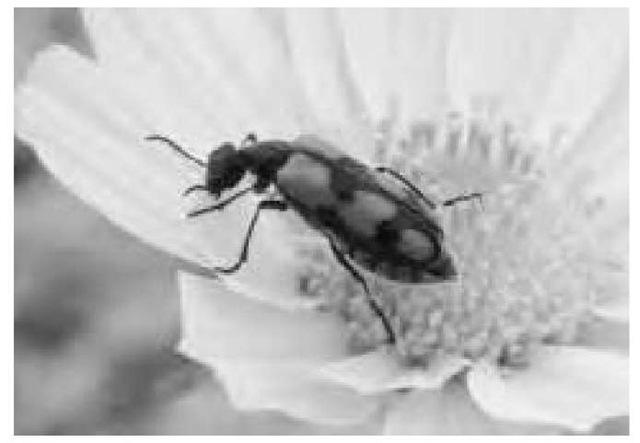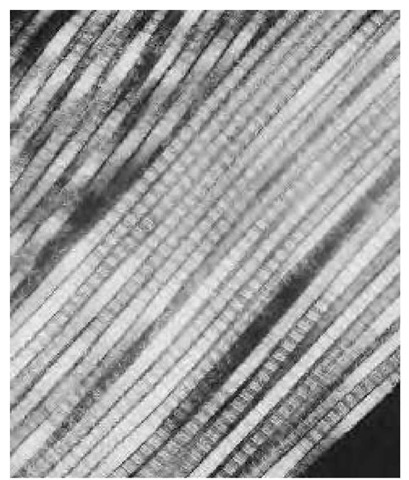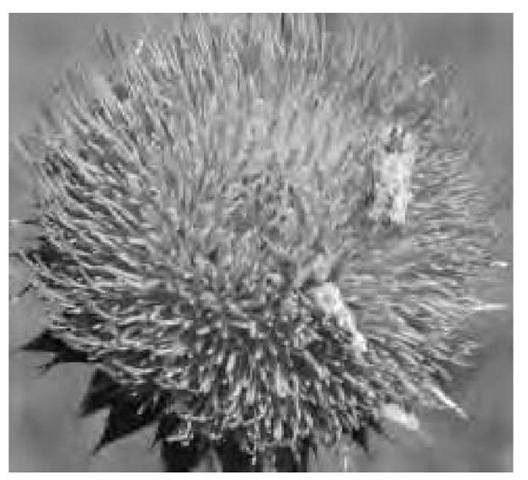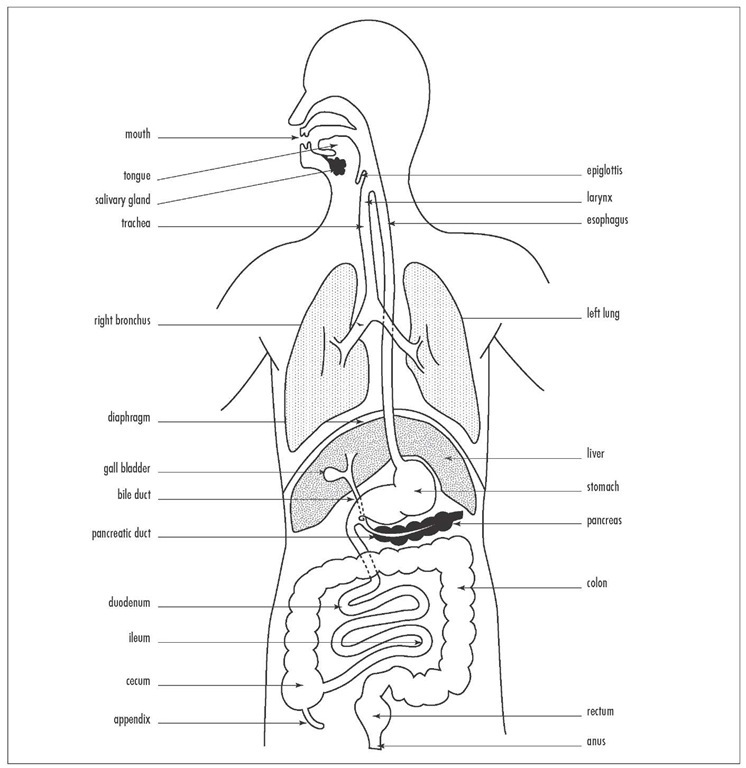Coelacanth A 400-million-year-old "living fossil," believed to have gone extinct 65 million years ago during the Cretaceous period and predating the dinosaurs by millions of years. The coelacanth was found alive in 1938 in South Africa. Today, Latimeria chalumnae and Latimeria menadoensis represent a once widespread family of sarcopterygian (fleshy-finned) coelacanth fishes. There are more than 120 species known from fossils.
Coelom A fluid-filled body cavity lined with meso-derm where organs can develop.
Coelomate Any organism whose body cavity is lined by mesoderm; animals possessing a coelom. These included the phylas: Entoprocta, Ectoprocta, Phoroni-da, Brachiopoda, Mollusca, Priapulida, Sipuncula, Echiura, Annelida, Tardigrada, Pentastoma, Ony-chophora, Arthropoda, Pogonophora, Echinodermata, Chaetognatha, Hemichordata, and Chordata.
Coenocytic Having multiple nuclei embedded in cytoplasm without cross walls; the nuclei lie in a common matrix. Also denotes a mycelium where the hyphae lack septa, i.e., members of the Oomycota and Chytridiomycota.
Coenzyme A low-molecular-weight, nonprotein organic compound (often a nucleotide) participating in enzymatic reactions as a dissociable acceptor or donor of chemical groups or electrons. See also enzyme.
Coevolution The evolution of two species where the evolutionary changes in one of the species influences the evolution of the other. A classic example is the long, narrow bill of the hummingbird. It has coevolved with tubular flowers, and the adaptation of its bill allows it to feed on plants with long, tubular flowers. These flowers in turn have adapted (coevolved) for fertilization by the hummingbirds when they take their nectar.
Cofactor An organic molecule or ion (usually a metal ion) that is required by an enzyme for its activity. It may be attached either loosely (coenzyme) or tightly (prosthetic group).
Cohesion The force of attraction between molecules of the same substance that allows them to bind.
Coitus An alternative term for intercourse.
Coleoptera The taxonomic order that comprises the insect group of beetles, one of the most adaptable and numerous insect groups. Beetles go through complete metamorphosis, have their hind wings covered by their fore wings, and are found in a variety of habitats.
A blister beetle (chemically protected) located in the Kelso Dunes, California, that feeds on flowers and pollinates them in the process.
Collagen The most abundant fibrous protein in the human body (about 30 percent) and in the animal kingdom; shapes the structure of tendons, bones, and connective tissues. There are several types (I, II, III, IV) that are found in bone, skin, tendons, cartilage, embryonic tissues, and basement membranes.
Collecting duct The area in the kidneys where urine is collected. Distal tubules of several nephrons join to form the collecting duct, which consists of the arcuate renal tubule, straight collecting tubule, and the papillary duct. Also known as the tubulus renalis colligens, or renal collecting tubule.
Colored transmission electron micrograph (TEM) of a section through healthy collagen fibers from human skin. Collagen is the major structural protein in the body, forming a large part of bones, tendons, and tissues. Magnification unknown.
Collembola An arthropod order resembling small insects that are wingless and can jump remarkable distances.
Collenchyma cell one of the three major plant cell types (dermal, ground, and vascular). Collenchyma cells are part of the ground tissue (ground tissues include parenchyma, collenchyma, and sclerenchyma cells) and are elongated and thick, with uneven cell walls and arranged in strands to provide support in areas of the plant that are growing.
Colony-stimulating factor (CSF) The category includes granulocyte-colony stimulating factor (G-CSF), macrophage-colony stimulating factor (M-CSF), and granulocyte-macrophage-colony stimulating factor (GM-CSF). These are all cytokine proteins that stimulate growth and reproduction of certain kinds of blood cells in the bone marrow. Also referred to as growth factors. The production of white blood cells is controlled by colony-stimulating factors. Cancer chemotherapy and inherited disorders are among the causes of low white-cell counts, which lower resistance to infection. Thus, CSFs are being investigated not only as a way to counteract low white-cell counts but also as a way to produce specific types of white blood cells. In addition, there is hope that CSFs can stimulate the body to produce additional bone marrow as well as cause some cancer cells to stop dividing.
Combinatorial library A set of compounds prepared by combinatorial synthesis.
Combinatorial synthesis A process to prepare large sets of organic compounds by combining sets of building blocks.
Commensalism One of the forms of symbiosis. In this case, one organism benefits and the other is not affected.
Community All of the organisms, plant and animal, that inhabit a specific geographic area.
Companion cell A type of plant cell that is connected to a sieve-tube member, making up the phloem tissue. It retains the nucleus and dense cytoplasm to service adjacent sieve tube members, and it helps pump sugars into the phloem.
Comparative molecular field analysis (CoMFA) A three-dimensional quantitative structure-activity relationship (3D-QSAR) method that uses statistical correlation techniques for analysis of the quantitative relationship between (a) the biological activity of a set of compounds with a specified alignment and (b) their three-dimensional electronic and steric properties. other properties such as hydrophobicity and hydrogen bonding can also be incorporated into the analysis. See also three-dimensional quantitative structure-activity relationship.
Competitive exclusion principle (Gause’s law) The condition where one species is driven out of a community by extinction due to interspecific competition; one species will dominate the use of resources and have a reproductive advantage, forcing the other to disappear.
Competitive inhibitor A substance that resembles the substrate for an enzyme, both in shape and size, and competes with the substrate for the substrate binding site on the enzyme, thereby reducing the rate of reaction by reducing the number of enzyme molecules that successfully bind.
Complementary DNA (cDNA) A laboratory-produced DNA section that is created by extracting a single-stranded RNA from an organism as a template and transcribing it back into a double-stranded DNA using the enzyme reverse transcriptase. However, the cDNA does not include introns, those portions of the DNA that were spliced out while still in the cell. Used for research purposes and can be cloned into plasmids for storage.
Complement fixation The consumption of complement, a complex of nine blood serum proteins that interact sequentially with specific antibodies (and concentrates in inflamed regions), by an antibody-antigen reaction containing complement-fixing antibodies. Used as a test to detect antibodies that react against a particular antigen such as a virus.
Complement system A set of 30 glycoproteins in the blood serum in the form of components, factors, or other regulators that work at the surface of cells as receptors. Inactive until activated by immune responses, the system acts to dissolve and remove immune complexes and kill foreign cells.
Complete digestive tract (alimentary canal) A tube that has an opening and end (mouth and anus) that is used in digestion. The complete digestive tract is one where food is ingested at one end of the tract, the mouth, and wastes from digestion are passed out of the tract at the other end, the anus. An incomplete digestive tract has just one opening used both to take in food and to eliminate wastes.
Complete flower Any flower that has all four major parts: sepals, petals, stamens, and carpels.
Compositae (Asteraceae) The composites (also known as the daisy or sunflower family), Compositae or Asteraceae, are one of the largest plant families, containing almost 20,000 species. Most of these species are herbs, but there are also some shrubs, trees, and vines. The family includes many edible salad plants (e.g., lettuce, endive, chicory, and artichoke); cultivated species such as the marigolds, daisies, sunflowers, and chrysanthemums; as well as many common weeds and wildflowers. It is primarily the latter, for example, ragweed and mugwort, that are involved in pollen-induced seasonal allergies.
Ragweed (Ambrosia)
Ragweed refers to the group of approximately 15 species of weed plants, belonging to the Compositae family. Most ragweed species are native to North America, although they are also found in Eastern Europe and the French Rhone Valley. The ragweeds are annuals characterized by their rough, hairy stems and mostly lobed or divided leaves. The ragweed flowers are greenish and inconspicuously concealed in small heads on the leaves. The ragweed species, whose copious pollen is the main cause of seasonal allergic rhinitis (hay fever) in eastern and middle North America, are the common ragweed (A. artemisiifolia) and the great, or giant, ragweed (A. trifida). The common ragweed grows to about 1 meter (3.5 feet); is common all across North America; and is also commonly referred to as Roman wormwood, hogweed, hogbrake or bitterweed. The giant ragweed, meanwhile, can reach anywhere up to 5 meters (17 feet) in height and is native from Quebec to British Columbia in Canada and southward to Florida, Arkansas, and California in the United States.
An example of pollinators (moths) and a plant in the Compositae family (thistle flower) from Painted Rock, Colorado.
Due to the fact that ragweeds are annuals, they can be eradicated simply by mowing them before they release their pollen in late summer.
The complete digestive tract is one where food is ingested at one end of the tract, the mouth, and wastes from digestion are passed out of the tract at the other end, the anus.
Mugwort (Artemisia vulgaris, A. campestris, A. dra-cunculus, A. rupestris, A. mutellina, A. absinthium, A. maritima, A. austriaca, A. pontica, A. laciniata, A. abrotanum, A. annua, A. tilessii) A shrubby weed most commonly found on wasteland, mugwort can reach heights of up to 2 meters (7 feet) and is characterized by quite small, yellow to reddish brown flowers and a woody stem. The mugwort pollen season (in central Europe) is generally late July to September, with a peak around mid-August. Mugwort is known to cross-react with almost all members of the Compositae family, especially the ragweeds, as well as dandelions, sunflowers, chamomille, and all daisylike flowers. Mugwort also displays an important cross-reaction in the context of food allergies to celery.
Compound The combination of two or more different elements, held together by chemical bonds. The elements in a given compound are always combined in the same proportion by mass (law of definite proportion).
Compound eye A multifaceted eye found in most invertebrates. The eye is composed of many separate cylinder-shaped (hexagonal) units called ommatidia. Each ommatidium has its own surface area, lens (crystalline cone), light receptors (retinulae), and optic nerve fiber. The images from the collection of ommatidia are then processed.




